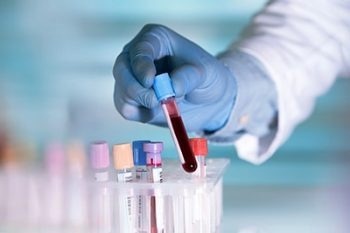Most cancer diagnostic procedures, like endoscopies, biopsies, and mammograms, are stressful and invasive. Although blood samples may be a less unpleasant option, only a few forms of the disease can as of now be diagnosed this way. However, investigators reporting in ACS Sensors have developed a simple method for detecting cancer-related molecules in exosomes in plasma and effectively distinguishing between malignant and benign samples.
 A blood test could someday diagnose cancers by analyzing the genetic material in exosomes. Image Credit: angellodeco/Shutterstock.com
A blood test could someday diagnose cancers by analyzing the genetic material in exosomes. Image Credit: angellodeco/Shutterstock.com
Exosomes are small vesicles that separate from a host cell and contain cargo like nucleic acids, lipids, and proteins. This means they provide insight into the condition of the cell from which they originated. As a result, cancerous cells’ distinct intracellular environment will be reflected in their exosomes via biomarkers like micro RNAs (miRNAs).
miRNAs are very small nucleic acids that control protein expression in cells and can become dysregulated in tumors. As a result, targeting these exosomal miRNAs in a blood test could one day identify cancerous cells.
However, quantifying miRNAs has been challenging since they are present in exosomes at very low levels, necessitating tedious processes that can incorporate contamination and produce unreliable results. As a result, using the gene-editing tool CRISPR, some researchers examined RNA and proteins in vesicles.
Hua Gao, Kaixiang Zhang, and colleagues, on the other hand, wanted to create a sensitive, reliable, and effective method for detecting the small number of cancer-related exosomal miRNAs using a distinct CRISPR system with exceptional RNase activity.
To develop the detection method, the researchers devised a CRISPR/Cas13a system that cut apart a fluorophore and quencher-labeled reporter molecule before packing it into a liposome—essentially a tailored exosome. When the two compartments merged, the CRISPR cargo would interact with the exosomal genetic material.
If the target miRNA sequence was present, the Cas13a protein was activated and cut the reporter molecule apart, resulting in a fluorescent signal. The team focused on miRNA-21, which is involved in the development of several diseases, including breast cancer, in these experiments. With high sensitivity, the method identified this miRNA within a mixture of similar sequences.
The method was also tested on groups of exosomes derived from healthy human cells and groups derived from breast cancer cells in other experiments. The system consistently distinguished cancer-related exosomes from those derived from healthy cells, indicating that it could be used as a cancer diagnostic tool. According to the researchers, by analyzing blood samples, this method has the potential to speed up and simplify cancer diagnosis and monitoring.
Source:
Journal reference:
Zhang, J., et al. (2023) Highly Effective Detection of Exosomal miRNAs in Plasma Using Liposome-Mediated Transfection CRISPR/Cas13a. ACS Sensors. doi.org/10.1021/acssensors.2c01683.